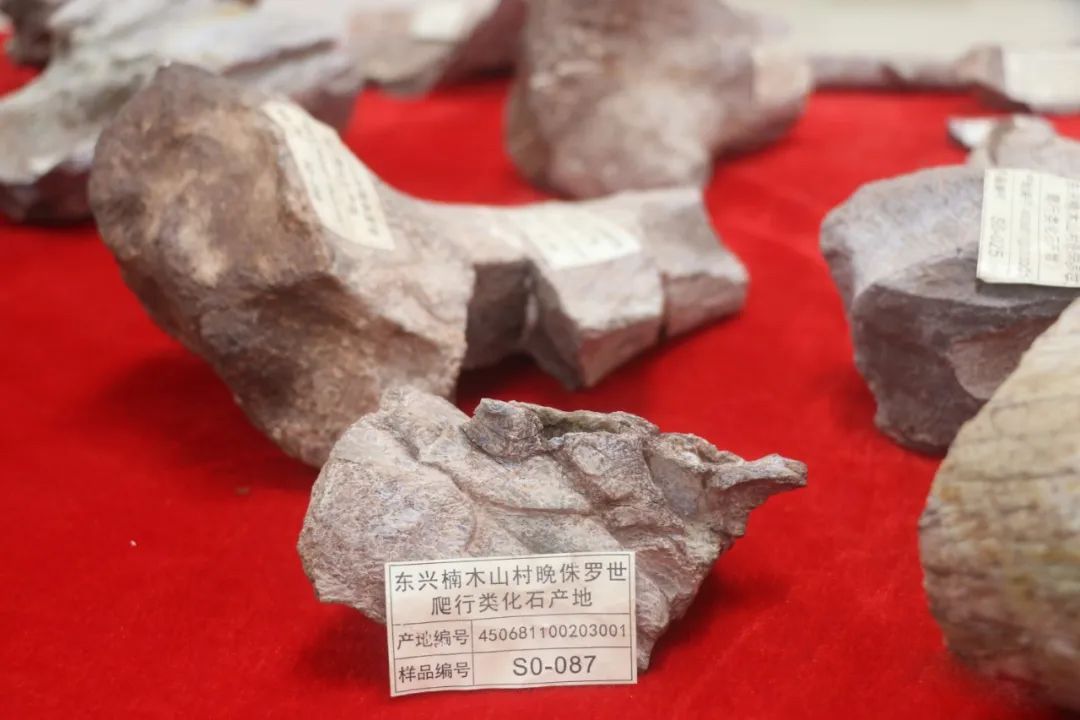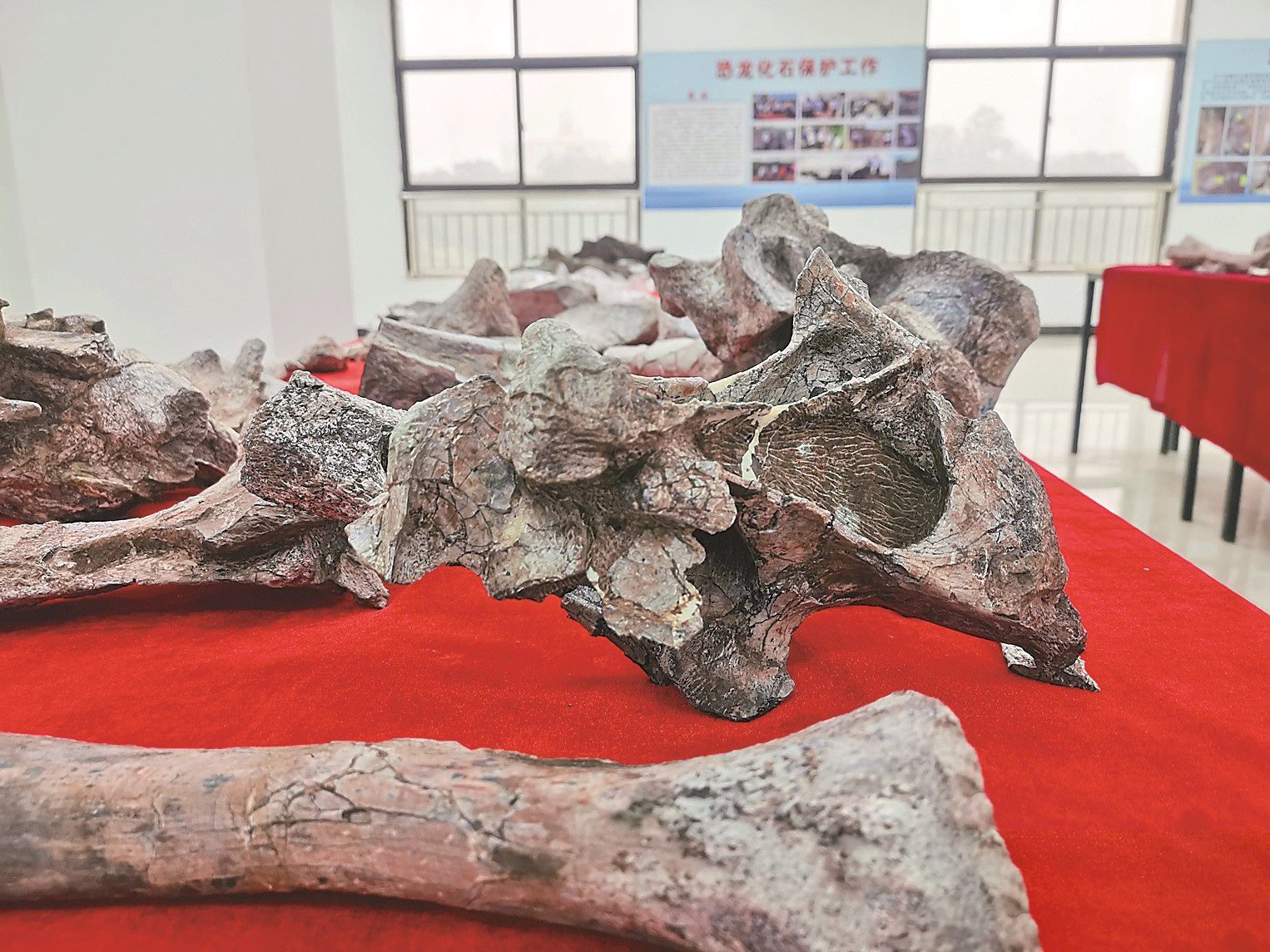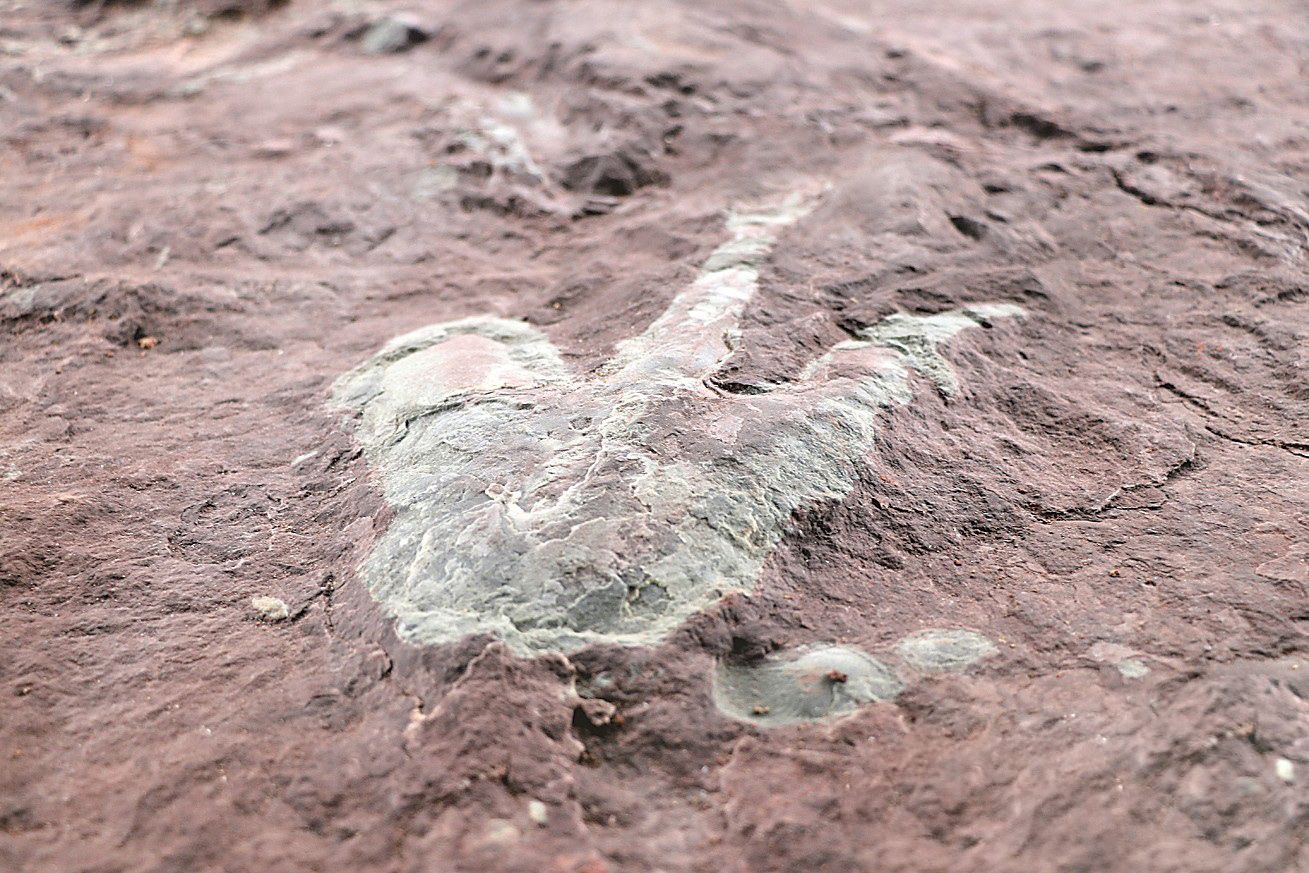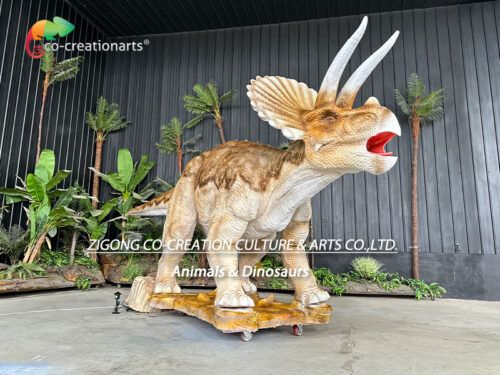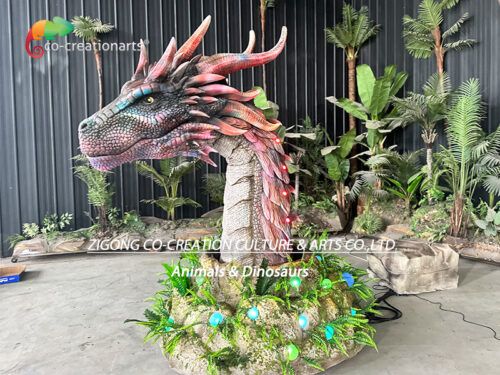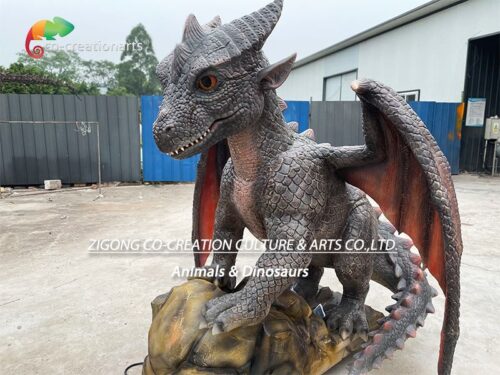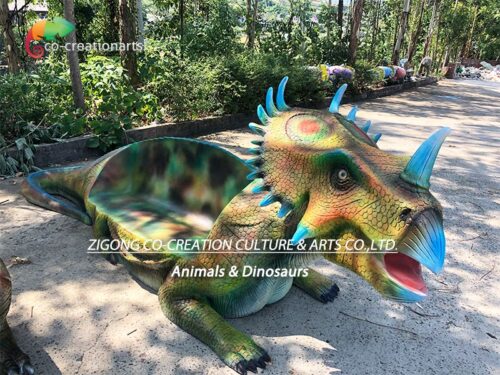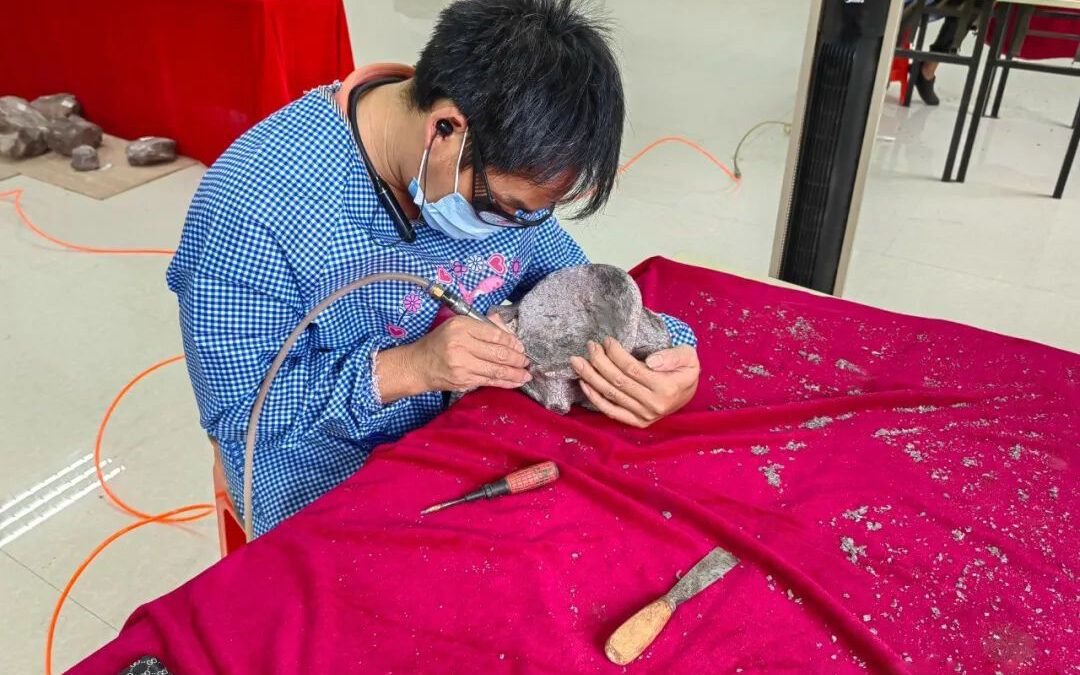
by artfty | Feb 8, 2023 | Paleontological Science
A dinosaur fossil unearthed in 2021 at the construction site of the front road of a high-speed railway construction project in Dongxing City has completed the first stage of restoration after a one-month restoration by technicians from the museum of Hebei University of Geosciences.
On February 3rd, the reporter came to the Dongxing Dinosaur Fossil Herbarium and saw that the dinosaur fossils collected in the room were arranged neatly, each fossil was numbered in detail, and the restored dinosaur fossils showed clear skeletal Outlines. It is known that in 2021, 363 dinosaur fossils have been excavated during the construction of the front road of Dongxing high-speed railway construction Project. At present, experts have repaired the cervical vertebra, dorsal vertebra, tail vertebra, neck rib, femur and other skeletal fossils, which are preliminatively determined to be sauropod dinosaur fossils.
Zeng Chunjun, director of the technology department of the Museum of Hebei University of Geosciences, who participated in the restoration work, said that before the Spring Festival, they carried out restoration work on the missing dinosaur fossils, mold making, mold turning, and scaffolding, and the progress was relatively smooth. For now, the restoration work has been suspended, pending the next discovery of new dinosaur fossils.
The reporter saw in the dinosaur fossil excavation site, the site set up a enclosure protective awning, to protect the exposed dinosaur footprints fossil specimens. Remarkably, five dinosaur footprints, about the size of a human hand, are spaced out on a boulder. According to the staff, the footprint fossils and bones they found are different kinds of dinosaur fossils, and the expert study determined that they were theropod dinosaur footprint fossils. It is understood that the footprint remains fossil and bone solid fossil are formed by dinosaurs in different nature and buried environment. It is often difficult to have two fossils in the same formation on a smaller scale. The simultaneous discovery of two fossils at the same site in Dongxing is rare among dinosaur fossil excavations in China and has important research value.
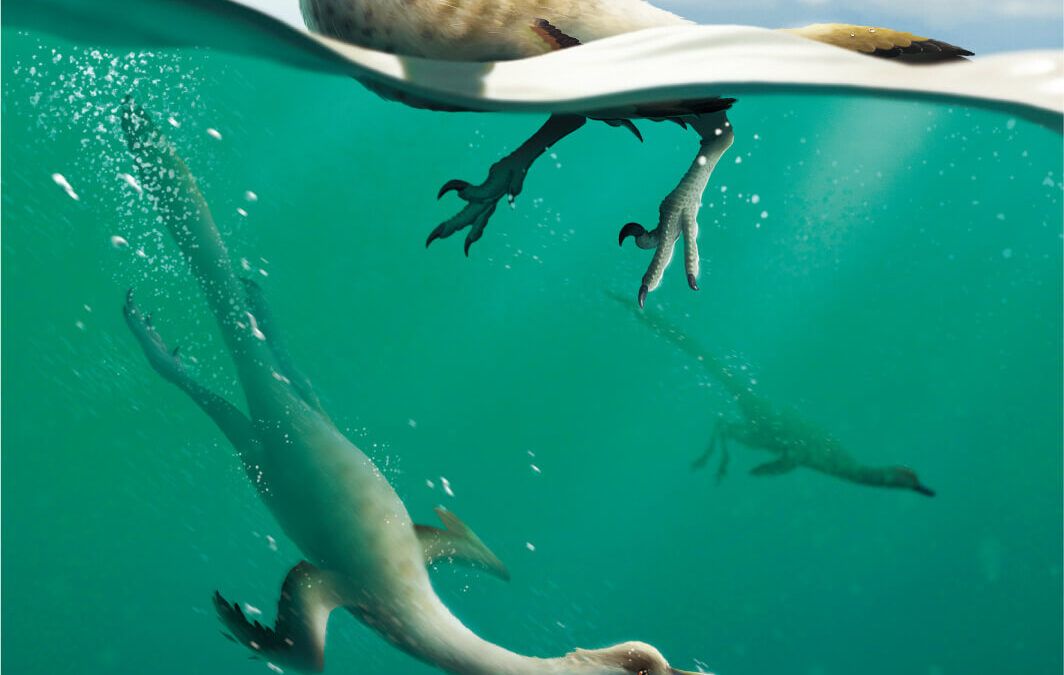
by artfty | Dec 4, 2022 | Paleontological Science
Science and Technology Daily reporter Zhang Mengran
An archaeological study published Tuesday in the journal Letters Biology describes a new species of dinosaur with a streamlined body shape similar to that of modern diving birds such as penguins and puffins. The discovery shows the first non-avian theropod dinosaur (that is, carnivorous dinosaurs that walked on two feet) with a streamlined body.
The Seoul National University team examined a sample of fossil remains to identify the new species, which has been named Natovenator polydontus, meaning ‘swimming hunter with many teeth’. The sample is a mostly intact skeleton consisting of a skull, spine, and the remains of one forelimb and two hind limbs.
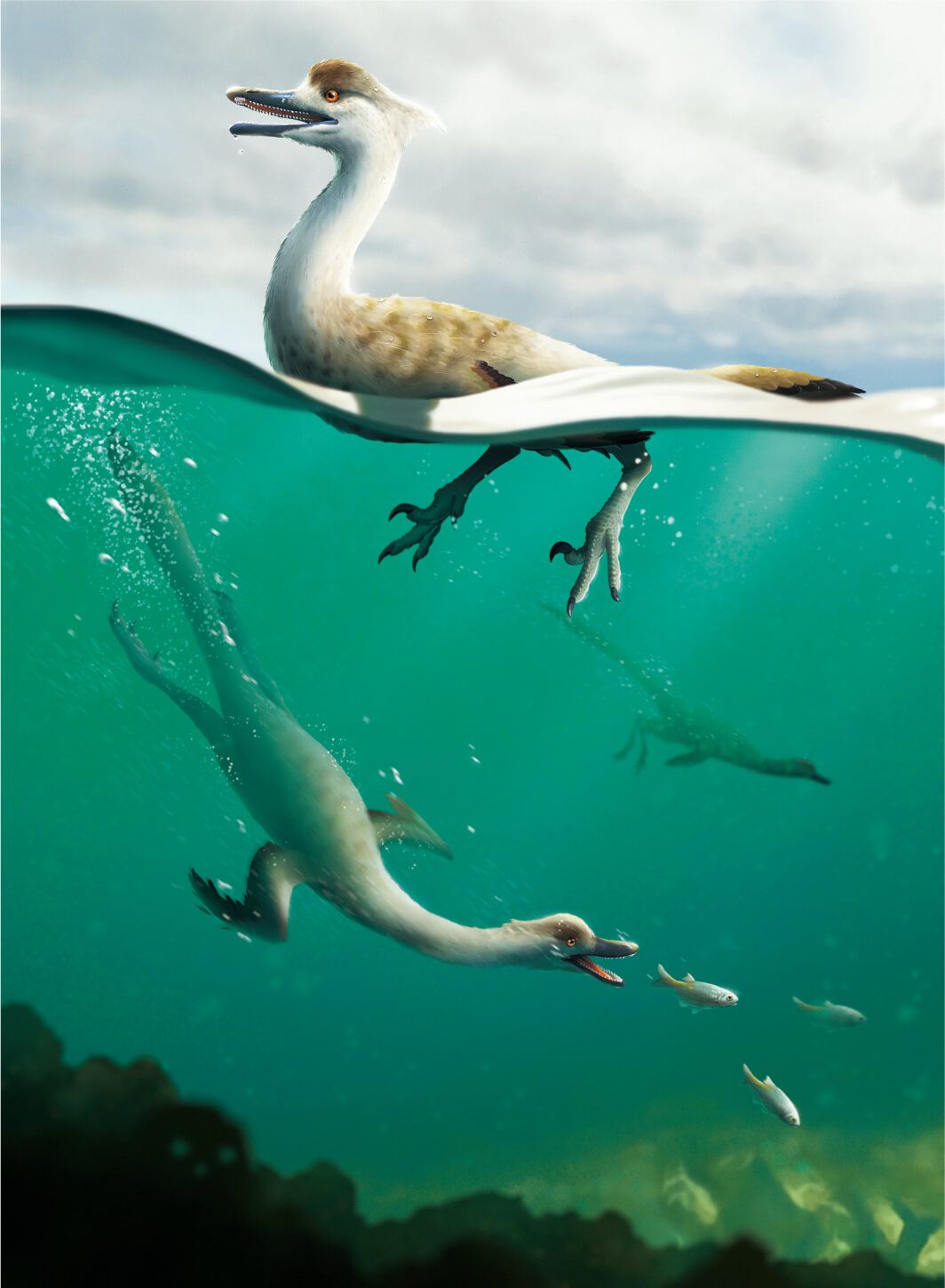
Reconstruction of a diving dinosaur. Photo: Communications Biology
The team reports several adaptations that suggest the “swimming hunter” dinosaurs may have been a semi-aquatic diving predator, including a streamlined body similar to that of modern diving birds (with ribs pointing toward the tail) and a long neck similar to that of modern water birds such as geese. These adaptations may have reduced the resistance the swimhunter encountered in the water, helping it to catch its prey.
The researchers also theorize that the swimhunter had an unusually large number of teeth for its jaw size, perhaps indicating a diet based on fish or insects, but further evidence (such as fossilized remains of stomach contents) is needed to confirm this. Analysis of the evolutionary relationship between the new species and other theropod dinosaurs suggests that it is related to Hazcaraptor, a class of non-bird theropod dinosaurs, which previous research suggested may have adapted to a semi-aquatic lifestyle, similar to today’s waterfowl.
Together, these findings suggest that the “swimming hunter” dragon was a semi-aquatic diving predator, providing more insight into the evolution of theropods.
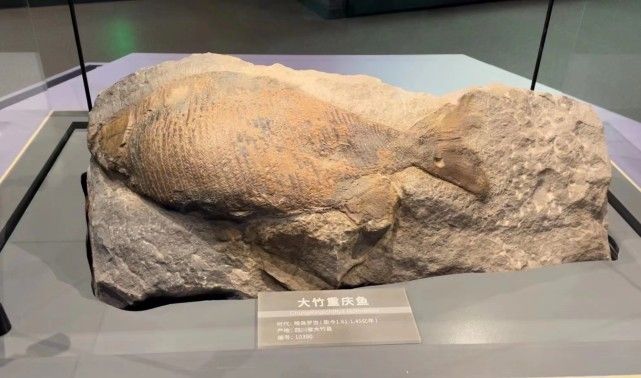
by artfty | Nov 22, 2022 | Paleontological Science
Chengdu Museum of Natural History (Chengdu University of Technology Museum) has a collection of nearly 30,000 pieces (groups), with the main collection directions of highlighting the earth sciences in Sichuan, paleontological fossils in Sichuan-Chongqing area, and biodiversity in Sichuan. The basic exhibition will take “Understanding the Earth Home, exploring the mystery of nature” as the general theme, “Earth treasure — environment and resources”, “ Dinosaur story — Origin and evolution”, “Life home — Conflict and harmony” as the unit display main line, with all kinds of natural specimens as the core support, combined with modern scientific and technological means. Topics such as geological processes and mineral resources, natural disasters and disaster prevention and reduction, origin and evolution of life and biodiversity will be revealed, and a content system with distinct themes, clear levels and prominent features will be constructed.

The permanent exhibition hall of the museum is the Department of Geology and Environment, the Department of Mineral Resources, the Department of Dinosaur Exploration, the Department of Dragon Travel in Sichuan and Chongqing, the Department of Life Exploration, and the Hall of Colorful Life. The exhibits on display include the Mamenxi dragon fossil of Hexuan, the Chongqing fish fossil of Dazhu, the iron meteorite of Longchang, the golden monkey of Sichuan, snow leopard, takin and so on. There are 2 temporary exhibition halls, which can plan and hold temporary exhibitions and special exhibition activities with different themes according to the collection resources and cultural characteristics.
Department of Geology and Environment
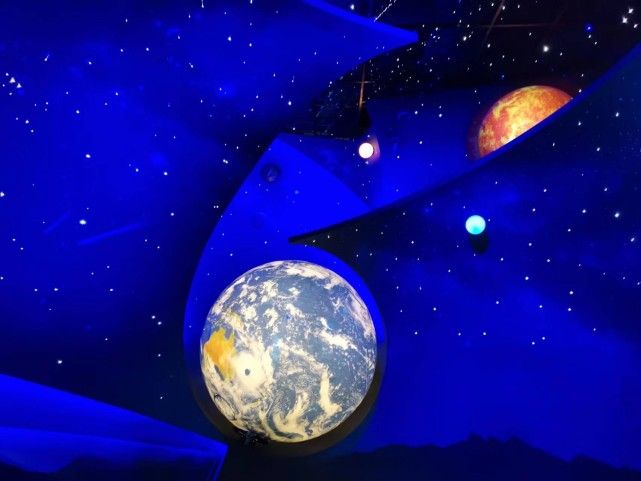
Through the AR digital telescope in front of the sand table, visitors can see a digital intelligence model of Chengdu plain which is superimposed by real sand table and virtual reality. The information of Chengdu’s “water system”, “mountain system”, “species” and “minerals” corresponding to the layout of the sand table can be presented one by one on the physical sand table.
“ Dinosaur Hall”
Through digital touch display technology, visitors can “revive” the Mamenxi dragon of Hechuan hundreds of millions of years ago. They can also touch control the breathing of the dinosaur and observe the operation of its organs for interactive experience of virtual feeding.
“Longxing Sichuan-Chongqing Office”
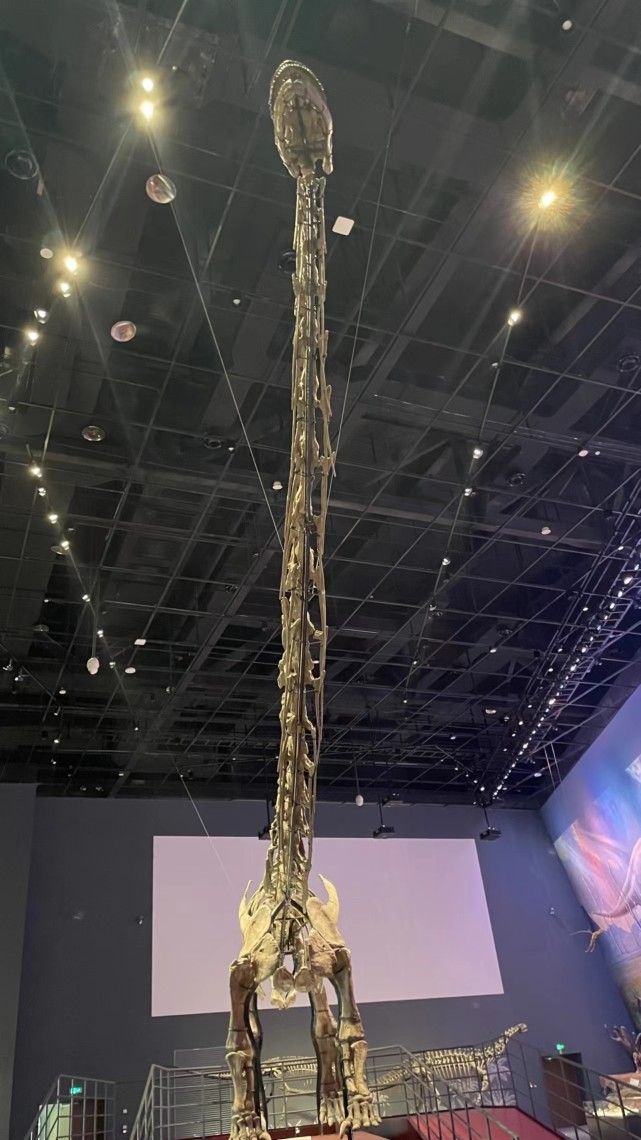
The fossil that attracts the most attention is the largest dinosaur fossil in Asia, the 22-meter-long and 4-meter-high Mamenxi dragon fossil in Hechuan, which is placed in the C position.
Department of Mineral Resources
Inside the tangible color of different ores, minerals, especially all kinds of jade stone, shining in the light of the mysterious luster. For those who like rare mineral gems, you can not only enjoy the elegance of various gems, but also have a hands-on experience. The exhibition hall has an experience desk, where visitors can hold various ores in their hands and carefully observe them. They can also scratch and rub on the porcelain plate to observe the color of mineral powder, so as to identify the finish color and hardness of minerals.
“Source of Life Exhibition Hall”
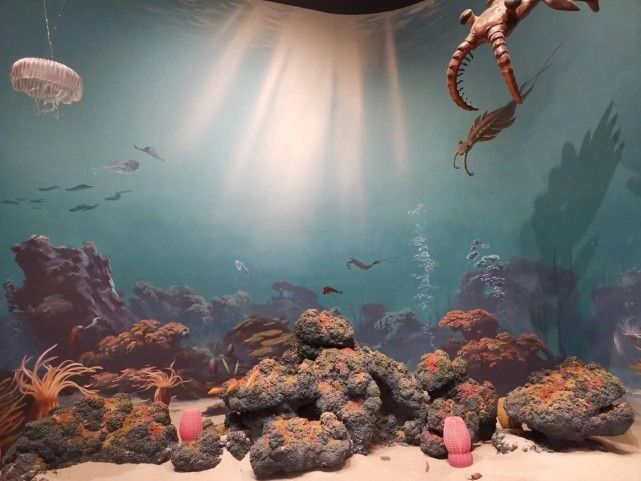
With “the surprise of finding life” as the main story line, it tells the origin of life on Earth and the history from the birth of life to the emergence of mammals, reproducing the ancient stories in the long river of life.
“Colorful Life Exhibition Hall”
Centering on the theme of “biodiversity”, the research results of natural specimens and their preservation environment are used to construct a natural exhibition with distinct themes, rich connotations, scientific, informative, ornamental and interesting.
Chengdu Daily Jinguan News reporter Wang Jia Photo Wang Jia responsible editor He Qitie Intern editor Lu Yarui
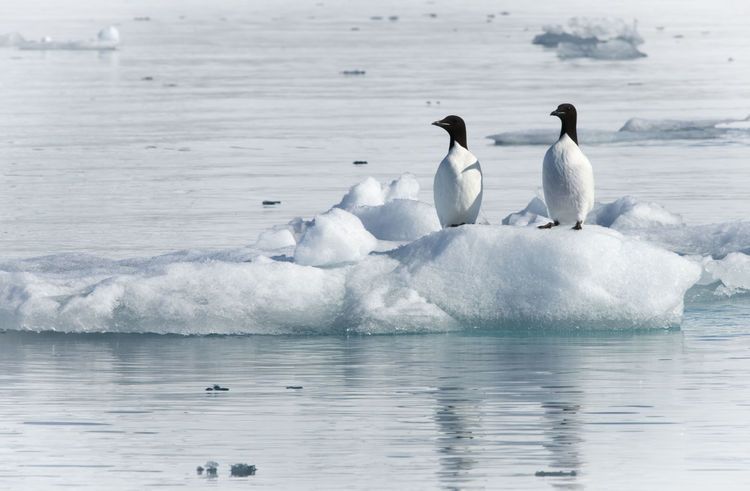
by artfty | Aug 4, 2022 | Paleontological Science
Last September, China successfully completed its 12th Arctic scientific expedition. On April 26 this year, the “Snow Dragon” returned with honors, which also marked the perfect conclusion of China’s 38th Antarctic scientific research activity.
Is the Antarctic colder or the Arctic colder? Are icebergs as salty as sea water? Are there volcanoes in the cold polar regions? What are the magical animals and plants in the frigid polar regions? Dinosaurs have been found in the polar regions? Why do humans conduct polar surveys? What kind of experience is it in polar scientific research?
Voice of China and CCTV video, together with the youth science and technology center of the China Association for science and technology, jointly launched the all media science popularization column – the master class “scientists talk about science”. 20 academicians and celebrities talked about hot issues and answered questions for the public on science popularization. In this issue, let’s welcome Liu Jiaqi, academician of the Chinese Academy of Sciences, and Liu Ying, director of the editorial department of natural history, to take us into the polar region.
Is the Antarctic colder or the Arctic colder?
The Arctic is surrounded by land and the Arctic Ocean in the middle. Liu Jiaqi said that although the surface of the Arctic Ocean is all ice, the thickness of the ice is not large, with an average thickness of about three meters, and the total ice volume is less than one tenth of the Antarctic ice volume.
Unlike the north pole, the south pole is surrounded by the sea – Antarctica, which covers an area of more than 14 million square kilometers. Because it is covered with ice and snow with an average thickness of more than 2300 meters, the average height of Antarctica is higher than that of other continents.
Liu Jiaqi pointed out that Antarctica is the last discovered continent on earth and the only one without human settlement at present. The climate in Antarctica is drier. The annual precipitation is about 50 mm a year, and the precipitation at the south pole is almost zero.
In addition, the Antarctic is colder than the Arctic. The lowest natural temperature measured in Antarctica is minus 89.2 º C, which is the lowest temperature measured in nature at present.
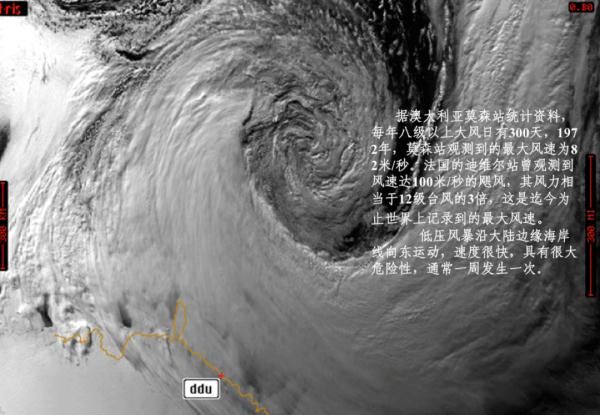
Liu Jiaqi said that what is more terrible than the severe cold is the strong wind. “When I was exploring the south pole, I didn’t think it was terrible to be cold, but the wind was terrible. According to the records of some investigation stations, there were winds of force 8 or more in the south pole for about 300 days a year. When the wind was strongest, the wind speed could reach 80 meters to 100 meters per second, which was about three times faster than the speed of a typhoon of force 12. If it was caught by the wind, it would be fatal.”
Are there volcanoes in the cold polar regions?
Liu Jiaqi said that there are volcanoes in both the north and south poles. “Although the polar region is covered with ice and snow, it is also in full swing. There are two modern volcanoes in Antarctica, one is deception island volcano in the South Shetland Islands, and the other is Erebus volcano in the Ross Sea.”
Both mount Erebus and mount deception are active volcanoes. Among them, Mount Erebus is the largest volcano in Antarctica, with a height of more than 3000 meters. There were volcanic eruptions in 1900 and 1902.
There are also volcanoes in the Arctic circle. Taking Iceland as an example, Liu Jiaqi said, “Iceland is called Iceland because of its cold, but in fact it is also a fire island. 85% of Iceland is volcanic. Therefore, the polar regions are not only cold but also hot.”
Polar volcanic eruptions will have a certain impact on the natural environment, but will not cause earth shaking changes. Liu Jiaqi said, “there are too many volcanoes in the whole earth, thousands. If you count the volcanoes under the sea, it will be tens of thousands. Therefore, it cannot be said that volcanic eruptions in the Antarctic and Arctic will lead to the destruction of the earth. Volcanic eruptions are indeed enough to cause a certain degree of disaster in local areas, but it is not enough to say that the earth will complete a life destruction.”
Are icebergs as salty as sea water?
Liu Jiaqi said that icebergs are not as salty as sea water. The melting water of polar icebergs is fresh water. “Nearly 97% of the water in the whole earth is salt water and 3% is fresh water. Of these 3%, about 70% is frozen in the Antarctic and Arctic. The ice and snow in the polar regions are fresh water.”

What are the magical animals and plants in the frigid polar regions?
Although the polar climate conditions are harsh, there are still animals and plants living, but there are also differences between the north and south poles. For example, in the Arctic, in addition to the polar bear we are familiar with, there is a bird called tern.
Liu Jiaqi said that this kind of white birds, which are slightly larger than swallows, are very powerful. They usually spend summer in the polar regions. If the Arctic is summer, it lives in the Arctic. If the Antarctic is summer, it lives in the Antarctic. Terns migrate back and forth between the north and south poles every year. “In 2004, someone picked up a dead tern. It was wearing a ring. This ring was worn in 1970. After 34 years, it means that this tern has run 34 times back and forth in the north and south poles, and has roughly flown more than 1.5 million kilometers.”
Liu Jiaqi said that many plants can be seen in the Arctic. “From higher plants to lower plants, they are generally herbaceous plants, without woody plants. The more famous are higher plants such as fairy wood, and Arctic cotton, which is called ‘Edelweiss’.”
Although the Antarctic is covered with ice and snow all year round, it is also full of vitality. Liu Jiaqi said that most creatures in Antarctica live in the sea. “Among them, penguins are the most familiar. There are also many kinds of penguins, among which emperor penguins belong to the aristocracy among penguins.”
There are almost no higher plants on the land of Antarctica, only some lichens and mosses, so Antarctica is also known as the “world without flowers”. Liu Jiaqi pointed out, “lichens are the most common plants that can be seen on the coast of Antarctica. Generally speaking, it takes 100 years for a lichen to grow one centimeter. If it can grow to about 10 centimeters, it will have a growth period of about 1000 years.”
Dinosaurs were found in the polar regions?
The Antarctic continent is rich in animal and plant fossils, including dinosaurs. Antarctica was once a part of the primitive continent Gondwana, which began to split about 180 million years ago, first forming South America and Africa, and split off Antarctica about 130 to 140 million years ago. About 70 to 80 million years ago, at the end of the Mesozoic and early Cenozoic, Antarctica drifted to its current position.
So, did dinosaurs really exist in Antarctica? Liu Jiaqi said that the discovery of dinosaur fossils in polar strata did not mean that dinosaurs had lived in the Antarctic and Arctic. Liu Jiaqi pointed out that dinosaurs could not survive in the polar environment. The strata where dinosaur fossils were located drifted from places outside the polar region through plate movement. Therefore, dinosaurs cannot be considered to have survived there just because there are dinosaur fossils in the Antarctic and Arctic strata.
Why do humans go to the polar regions?
In the past 100 years, the global temperature has been rising, and the climate change is very intense. Liu Jiaqi said that in order to find out the causes of climate change, it is necessary to obtain relevant information from the polar regions, because there is almost no interference from human activities in the polar regions, and the real background values and natural conditions can be obtained.
Taking the ice amount in the Arctic as an example, Liu Jiaqi pointed out that the temperature increase in the Arctic is much more intense than that in mid latitudes, and the change of its ice amount is closely related to climate change. “Based on the amount of ice, the amount of ice in the Arctic will be reduced by about half in almost 100 years. A large amount of ice will melt into fresh water and enter the ocean. After the sea water is diluted, its proportion will also change, thereby affecting ocean currents. Changes in ocean currents will lead to climate change.”
\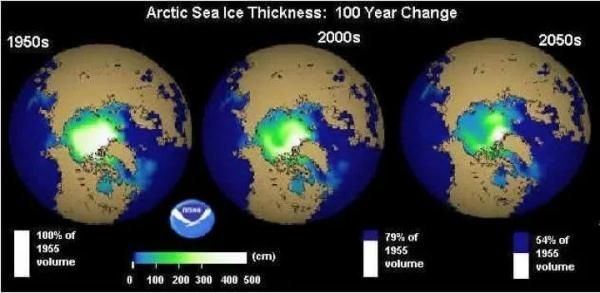
On the other hand, Antarctica and the Arctic are rich in mineral resources. At present, more than 200 kinds of minerals have been found in Antarctica, such as coal, oil, natural gas and even gemstones. In addition to mineral resources, Antarctica is also rich in biological resources. Liu Jiaqi said, “there are hundreds of millions of tons of krill in Antarctica. Without breaking the ecological balance, humans can catch 100million to 150million tons every year.”
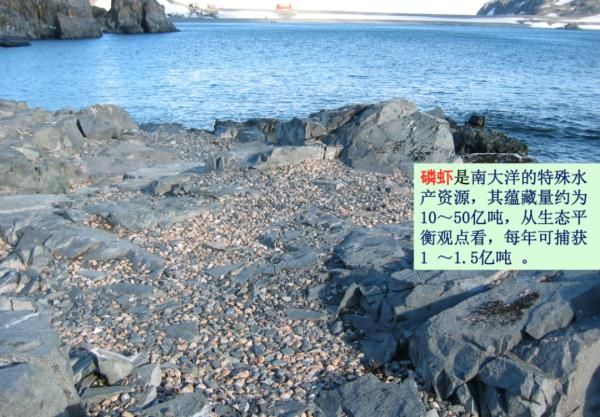
What achievements have China made in the polar expedition?
Liu Jiaqi said that China has made many achievements after more than 30 years of efforts since 1985. The first achievement is the establishment of an inspection station. “At present, there are five stations in our country among the 76 investigation stations in Antarctica. These five stations account for almost all the East, West, North and south of Antarctica. Zhongshan station is in the East, Great Wall Station is in the west, Kunlun station is in the middle, and a fifth station is built in Ross Bay in the south. It is a great thing that China can build five stations in a relatively short time, ranking fourth in the countries with Antarctic investigation stations.”
In polar scientific research, Chinese researchers have obtained a large amount of valuable information. The remote sensing geological map of Antarctica drawn by China has achieved “viewing Antarctica through ice”, helping scientific researchers further explore the unknown polar world.


